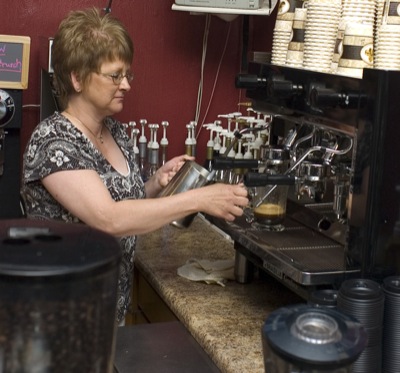Wednesday, June 6th, 2007
For 150 years, a brotherhood of firefighters
By Margie Wuebker

Photo by Mark Pummell/The Daily Standard
The current New Bremen-German Township Fire Department, located in the village administration building off North Washington Street, will be the scene of a 150th anniversary celebration June 16 and 17.
NEW BREMEN - It's been 150 years since a brotherhood of dedicated men first began putting out fires with hand-drawn pumpers.
The New Bremen-German Township Fire Department is marking its anniversary by celebrating a rich heritage dating back to 1857 and renewing a commitment to volunteer service in the future.
According to "Feuerwehr to Fire Department: The History of Fire Fighting in New Bremen," the community once boasted four fire departments. The Northern Fire Company was organized June 9, 1857, with its facility located on Main Street where the local post office now stands. The building also included the town hall and village prison.
Town councilors authorized the establishment of Ober Bremen Fire Company (later known as The Cataract Fire Company) on June 20, 1857. A newly purchased, hand-drawn fire engine, affectionately called Old Reliable, sailed into town on a Miami and Erie Canal boat. First located on Front Street, the department later moved to a new firehouse on South Washington Street, now part of the Crown Equipment Corporation complex.
The book lists Franz Gerhard Schulte as the first chief when the companies merged in 1884. Council subsequently approved the purchase of a new fire engine, hook and ladder truck and hose at a cost of $2,745.
The merger also involved The Alert No. 1 Hook and Ladder Company, which reportedly shared the engine house with Northern Fire Company. The fourth department, Old Reliable Fire Company, was formed in 1889 to protest Ober Bremen's purchase of a new fire truck. It disbanded in 1904 due in part to waning enthusiasm and difficulty operating the old hand-pump equipment, according to New Bremen Historic Association member Delores Stienecker.
The Cataract Fire Company outlasted the others, benefiting from motorization in 1926. It subsequently became the New Bremen Fire Department with the New Bremen-German Township name debuting Dec. 12, 1961. In February 1982, the department moved from the former South Washington Street location to the new municipal building on North Washington Street.
"I contacted Delores about putting together some kind of history for our anniversary," current fire Chief Bob Kuck says. "She and her team certainly got the ball rolling. They had to wade through old records written in German and put together a real nice book."
Kuck admits there is a lot of history sandwiched between the covers of the 40-page book.
Prior to the establishment of fire departments, residents formed bucket brigades to fight fires. The effort involved men, women and children - anyone who could lift the leather buckets.
A bell alerted firefighters and townspeople to a fire. Steam whistles came into use at the turn of the century. The village engineer would blast a coded signal to identify which of the four districts had a fire. The method was not infallible as a boiler shutdown resulted in no steam to sound warnings.
In 1917, a new system allowed telephone operators to trigger electric sirens as well as red lights on light poles at the community's two main intersections.
"Responding in timely fashion and an adequate water supply were problems in bygone times," Stienecker says. "Hand pumpers and hose carts were drawn by men running as fast and as far as they could. Horses were used for out-of-town assistance calls."
Records indicate Northern Fire Company personnel pulled their engine from the firehouse to one of the village's cisterns - a distance of 760 feet - and were able to "throw" water within 1 minute and 57 seconds as part of a test. A series of 25-foot deep cisterns capped with cast iron lids provided water for firefighting purposes as did the Lock One basin along the canal.
The cost of equipment has changed dramatically with the passage of time. Fire engines with all the bells and whistles run roughly six figures. Today's turnout gear runs $1,200 to $1,500 per person; black rubber coats cost $4 apiece in 1906, according to Kuck.
During the years, three men made the ultimate sacrifice in the line of duty. Henry Hartwig died March 18, 1892, of injuries sustained when gunpowder exploded as he and fellow members of the Northern Fire Company fought a blaze at Garmhausen Store in Lock Two.
More than a century elapsed before a silo fire and explosion claimed the lives of John Garman and Ken Jutte. The tragedy occurred Oct. 1, 2003, at Hoge Lumber Company in New Knoxville.
"Firefighters remain a brotherhood of dedicated individuals committed to service," Kuck says. "The time has come to celebrate our heritage."


